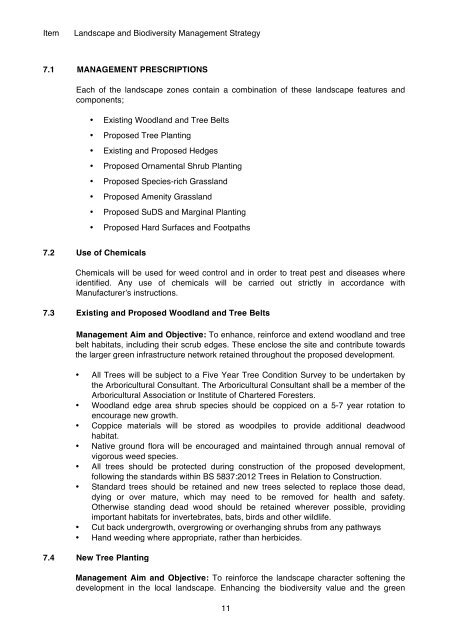Landscape and Biodiversity Management Strategy - Runnymede ...
Landscape and Biodiversity Management Strategy - Runnymede ...
Landscape and Biodiversity Management Strategy - Runnymede ...
Create successful ePaper yourself
Turn your PDF publications into a flip-book with our unique Google optimized e-Paper software.
Item<br />
<strong>L<strong>and</strong>scape</strong> <strong>and</strong> <strong>Biodiversity</strong> <strong>Management</strong> <strong>Strategy</strong><br />
7.1 MANAGEMENT PRESCRIPTIONS<br />
Each of the l<strong>and</strong>scape zones contain a combination of these l<strong>and</strong>scape features <strong>and</strong><br />
components;<br />
• Existing Woodl<strong>and</strong> <strong>and</strong> Tree Belts<br />
• Proposed Tree Planting<br />
• Existing <strong>and</strong> Proposed Hedges<br />
• Proposed Ornamental Shrub Planting<br />
• Proposed Species-rich Grassl<strong>and</strong><br />
• Proposed Amenity Grassl<strong>and</strong><br />
• Proposed SuDS <strong>and</strong> Marginal Planting<br />
• Proposed Hard Surfaces <strong>and</strong> Footpaths<br />
7.2 Use of Chemicals<br />
Chemicals will be used for weed control <strong>and</strong> in order to treat pest <strong>and</strong> diseases where<br />
identified. Any use of chemicals will be carried out strictly in accordance with<br />
Manufacturerʼs instructions.<br />
7.3 Existing <strong>and</strong> Proposed Woodl<strong>and</strong> <strong>and</strong> Tree Belts<br />
<strong>Management</strong> Aim <strong>and</strong> Objective: To enhance, reinforce <strong>and</strong> extend woodl<strong>and</strong> <strong>and</strong> tree<br />
belt habitats, including their scrub edges. These enclose the site <strong>and</strong> contribute towards<br />
the larger green infrastructure network retained throughout the proposed development.<br />
• All Trees will be subject to a Five Year Tree Condition Survey to be undertaken by<br />
the Arboricultural Consultant. The Arboricultural Consultant shall be a member of the<br />
Arboricultural Association or Institute of Chartered Foresters.<br />
• Woodl<strong>and</strong> edge area shrub species should be coppiced on a 5-7 year rotation to<br />
encourage new growth.<br />
• Coppice materials will be stored as woodpiles to provide additional deadwood<br />
habitat.<br />
• Native ground flora will be encouraged <strong>and</strong> maintained through annual removal of<br />
vigorous weed species.<br />
• All trees should be protected during construction of the proposed development,<br />
following the st<strong>and</strong>ards within BS 5837:2012 Trees in Relation to Construction.<br />
• St<strong>and</strong>ard trees should be retained <strong>and</strong> new trees selected to replace those dead,<br />
dying or over mature, which may need to be removed for health <strong>and</strong> safety.<br />
Otherwise st<strong>and</strong>ing dead wood should be retained wherever possible, providing<br />
important habitats for invertebrates, bats, birds <strong>and</strong> other wildlife.<br />
• Cut back undergrowth, overgrowing or overhanging shrubs from any pathways<br />
• H<strong>and</strong> weeding where appropriate, rather than herbicides.<br />
7.4 New Tree Planting<br />
<strong>Management</strong> Aim <strong>and</strong> Objective: To reinforce the l<strong>and</strong>scape character softening the<br />
development in the local l<strong>and</strong>scape. Enhancing the biodiversity value <strong>and</strong> the green<br />
11
















